
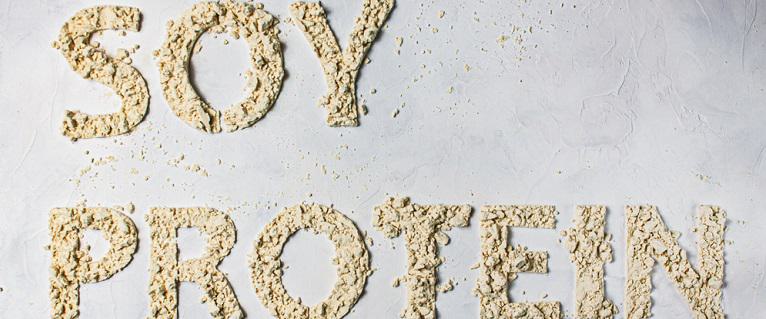
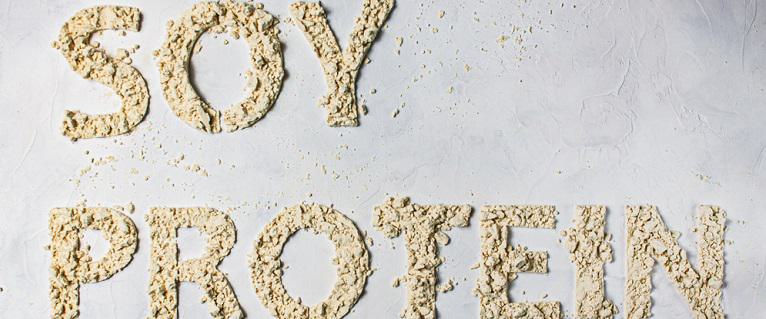
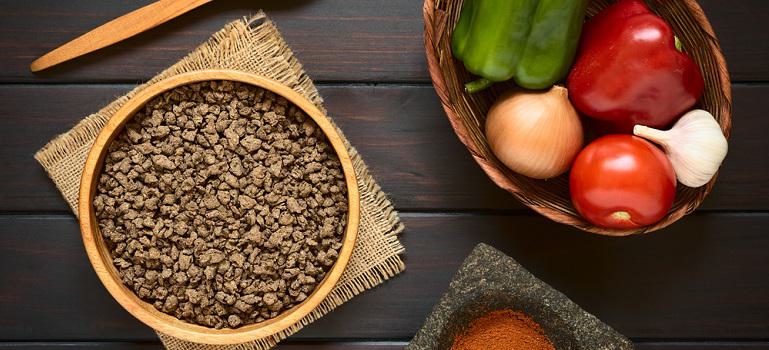 If youre asking yourself what is textured protein? Let us help. Textured soy protein, also known as textured vegetable protein (TVP), is a vegan protein product that's made primarily from soybeans. Versatile and easy to flavor, when seasoned with the right herbs and spices, this soy product can be used as a meat substitute in your favorite recipes. A favorite amongst plant-based eaters, TVP is an excellent way to boost a meal's protein content which is crucial for individuals not consuming animal protein on a regular basis. Now, that's not to say that meat-eaters can't enjoy this product as well. In fact, textured vegetable protein is commonly used as a meat extender in foods like burgers, taco meat and casseroles for people who do eat meat regularly.
Made from soy protein, TVP is high in protein and fiber while remaining low in fat. This makes it a favorite ingredient for people following low fat and low-calorie diets. Sold as slices, flakes, powder, granules and dried chunks, textured soy protein must be rehydrated before being used. While it can be enjoyed as is, it has a rather bland taste on its own, which is why many people prefer flavoring it before use. Luckily, because it's a dehydrated food, it readily absorbs the flavors from any liquid, allowing you to work it into nearly any type of cuisine. TVP can be used to make various dishes and is commonly used as a meat alternative in plates containing ground beef or meat chunks such as chili, burgers, taco, hand pies and lasagna.
If youre asking yourself what is textured protein? Let us help. Textured soy protein, also known as textured vegetable protein (TVP), is a vegan protein product that's made primarily from soybeans. Versatile and easy to flavor, when seasoned with the right herbs and spices, this soy product can be used as a meat substitute in your favorite recipes. A favorite amongst plant-based eaters, TVP is an excellent way to boost a meal's protein content which is crucial for individuals not consuming animal protein on a regular basis. Now, that's not to say that meat-eaters can't enjoy this product as well. In fact, textured vegetable protein is commonly used as a meat extender in foods like burgers, taco meat and casseroles for people who do eat meat regularly.
Made from soy protein, TVP is high in protein and fiber while remaining low in fat. This makes it a favorite ingredient for people following low fat and low-calorie diets. Sold as slices, flakes, powder, granules and dried chunks, textured soy protein must be rehydrated before being used. While it can be enjoyed as is, it has a rather bland taste on its own, which is why many people prefer flavoring it before use. Luckily, because it's a dehydrated food, it readily absorbs the flavors from any liquid, allowing you to work it into nearly any type of cuisine. TVP can be used to make various dishes and is commonly used as a meat alternative in plates containing ground beef or meat chunks such as chili, burgers, taco, hand pies and lasagna.
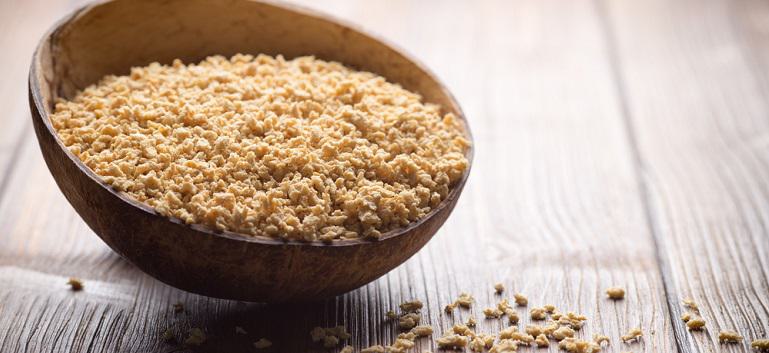 Now that you know a bit more about textured soy protein, you might be curious to know what benefits it offers. Aside from being an easy-to-use plant-based meat alternative, this soy product also has other benefits. With the right seasonings, it's enjoyable to eat and can provide bulk and texture to foods that ground meat often provides. Additionally, TVP has a long shelf life and is easy to transport, making it a product that will remain fresh in your pantry until you're able to use up the entire bag.
The nutritional makeup of textured soy protein is another thing to consider when purchasing this plant-based food. Soy is a food that contains no cholesterol and is low in sodium, making it useful for individuals watching their cholesterol levels. Additionally, it's a great source of protein, calcium and iron. When considering protein sources to add to your diet, you'll want to make sure that the ones you're using are a complete protein source and contain all essential amino acids. Textured soy protein is a complete protein and provides the body with nutrients that it can't make independently. While essential amino acids can be obtained by eating a healthy variety of plant-based foods, adding a complete protein like TVP to your diet is a great way to ensure that you're meeting specific nutrient requirements.
Now that you know a bit more about textured soy protein, you might be curious to know what benefits it offers. Aside from being an easy-to-use plant-based meat alternative, this soy product also has other benefits. With the right seasonings, it's enjoyable to eat and can provide bulk and texture to foods that ground meat often provides. Additionally, TVP has a long shelf life and is easy to transport, making it a product that will remain fresh in your pantry until you're able to use up the entire bag.
The nutritional makeup of textured soy protein is another thing to consider when purchasing this plant-based food. Soy is a food that contains no cholesterol and is low in sodium, making it useful for individuals watching their cholesterol levels. Additionally, it's a great source of protein, calcium and iron. When considering protein sources to add to your diet, you'll want to make sure that the ones you're using are a complete protein source and contain all essential amino acids. Textured soy protein is a complete protein and provides the body with nutrients that it can't make independently. While essential amino acids can be obtained by eating a healthy variety of plant-based foods, adding a complete protein like TVP to your diet is a great way to ensure that you're meeting specific nutrient requirements.
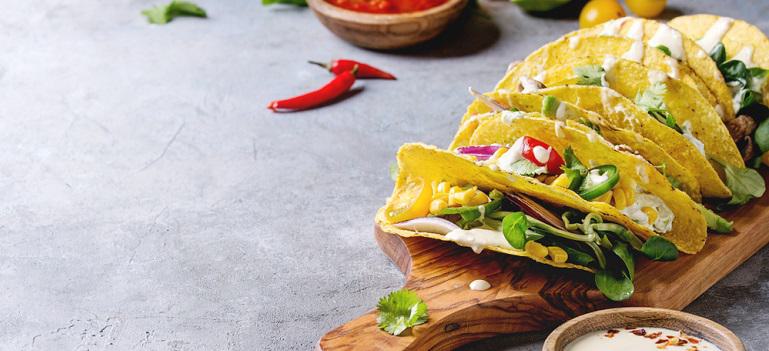 Taco Tuesday just got better, especially if you're following a plant-based diet. With the right blend of seasonings and a bit of TVP, Vegetarian Tacos can taste just as great as traditional ones. Pair your plant-based taco meat with everything you'd usually find in a taco, or turn it into a taco bowl for a lighter version of this favorite dish. Whatever you decide to enjoy these vegetarian tacos with, we're confident you won't be disappointed.
Knowing what ingredients you can regularly enjoy on a plant-based diet may be a bit confusing at first. While switching over to a plant-based diet will require you to change up your menu, it doesn't mean that you have to ditch your favorite foods and meals entirely. Several meat substitutes like textured soy protein make it easy to enjoy your favorite dishes sans animal products. Whether you choose to make textured soy protein at home with the help of a product like the Bob's Red Mill Textured Vegetable Protein Powder or purchase pre-made TVP products at your local health food store, this is one plant-based product you don't want to miss out on. We wish you a healthy, happy and plant-based day from everyone at Bob's Red Mill!
Love using textured vegetable protein in your recipes? We'd love to learn more about how you incorporate this popular meat alternative into your meals. Leave us a message in the comments below!
Taco Tuesday just got better, especially if you're following a plant-based diet. With the right blend of seasonings and a bit of TVP, Vegetarian Tacos can taste just as great as traditional ones. Pair your plant-based taco meat with everything you'd usually find in a taco, or turn it into a taco bowl for a lighter version of this favorite dish. Whatever you decide to enjoy these vegetarian tacos with, we're confident you won't be disappointed.
Knowing what ingredients you can regularly enjoy on a plant-based diet may be a bit confusing at first. While switching over to a plant-based diet will require you to change up your menu, it doesn't mean that you have to ditch your favorite foods and meals entirely. Several meat substitutes like textured soy protein make it easy to enjoy your favorite dishes sans animal products. Whether you choose to make textured soy protein at home with the help of a product like the Bob's Red Mill Textured Vegetable Protein Powder or purchase pre-made TVP products at your local health food store, this is one plant-based product you don't want to miss out on. We wish you a healthy, happy and plant-based day from everyone at Bob's Red Mill!
Love using textured vegetable protein in your recipes? We'd love to learn more about how you incorporate this popular meat alternative into your meals. Leave us a message in the comments below!